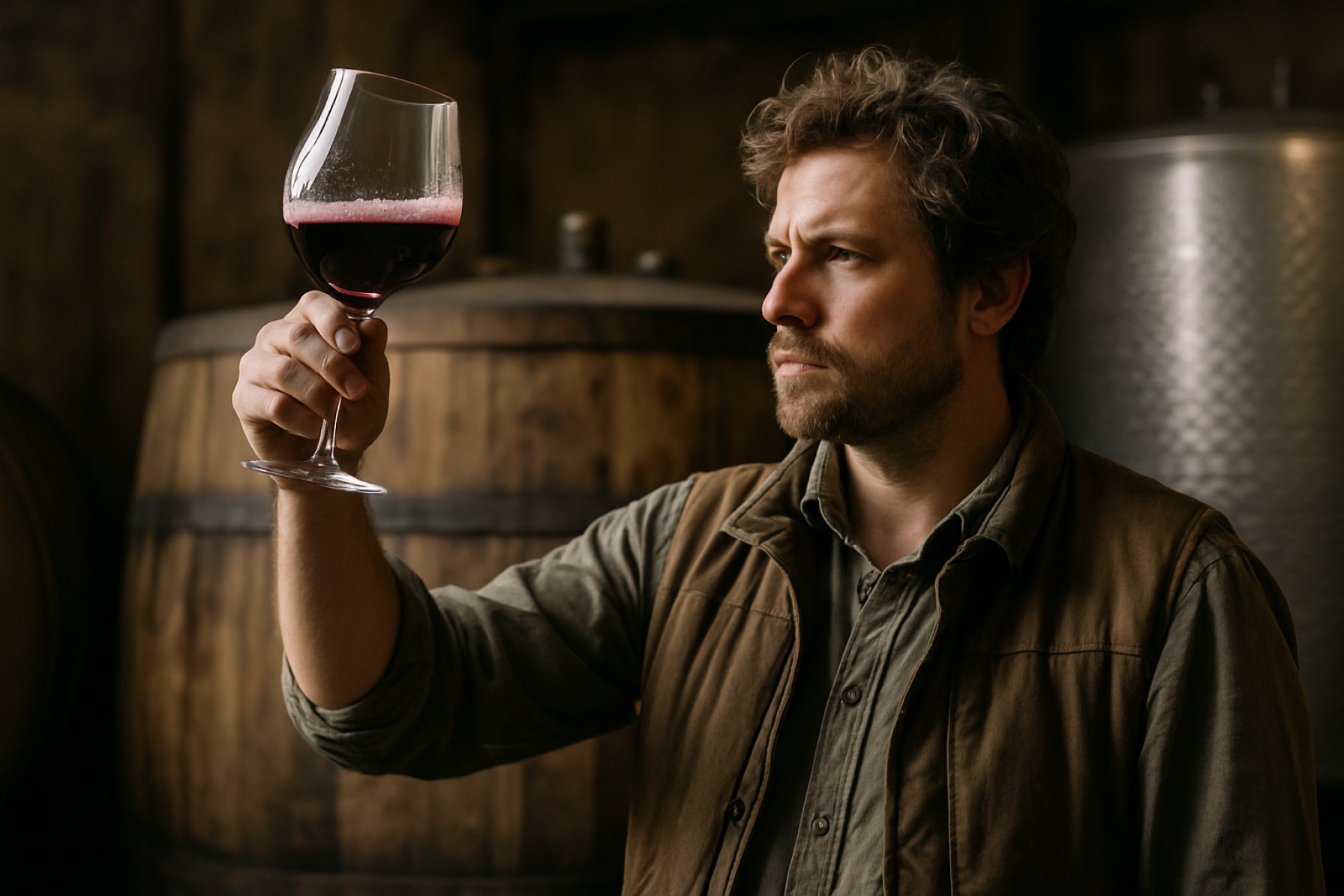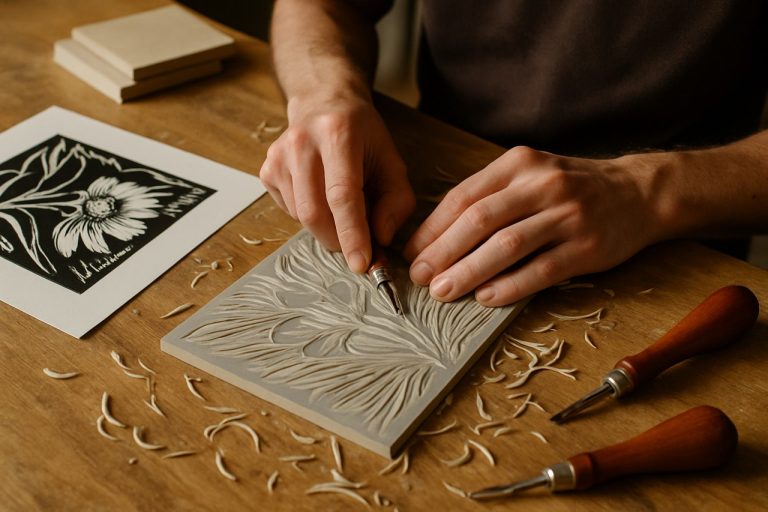
Oenology Meets Nature: How Spontaneous Fermentation is Revolutionizing Wine Science and Flavor. Discover the Microbial Mysteries and Future Trends Shaping the Next Generation of Winemaking. (2025)
- Introduction: Defining Spontaneous Fermentation in Oenology
- Historical Roots: Traditional Practices and Cultural Significance
- The Microbial Orchestra: Yeasts, Bacteria, and Their Roles
- Chemical Transformations: Flavor, Aroma, and Texture Development
- Technological Advances: Monitoring and Controlling Wild Fermentations
- Risks and Rewards: Quality, Consistency, and Safety Challenges
- Case Studies: Iconic Wines and Wineries Embracing Spontaneity
- Market Trends: Rising Consumer Interest and Growth Forecasts (Estimated 15% annual increase in natural wine demand, source: oiv.int)
- Sustainability and Terroir: Environmental and Regional Impacts
- Future Outlook: Innovations, Research Directions, and the Evolving Public Palate
- Sources & References
Introduction: Defining Spontaneous Fermentation in Oenology
Oenology, the scientific study of wine and winemaking, encompasses a broad spectrum of disciplines, from viticulture to microbiology. Central to this field is the process of fermentation, whereby grape sugars are converted into alcohol and other compounds by microorganisms. Among the various fermentation methods, spontaneous fermentation—also known as wild or natural fermentation—holds a distinctive place in both traditional and modern winemaking. Unlike controlled fermentations that utilize selected commercial yeast strains, spontaneous fermentation relies on the indigenous yeasts and bacteria naturally present on grape skins, in the vineyard environment, and within the winery itself.
The defining characteristic of spontaneous fermentation is its reliance on the native microbial community, which introduces a high degree of variability and complexity to the winemaking process. This method is often associated with the production of wines that express a unique sense of place, or “terroir,” as the local microbial flora can impart distinctive sensory attributes to the final product. The process typically begins with non-Saccharomyces yeasts initiating fermentation, followed by the dominance of Saccharomyces cerevisiae as alcohol levels rise. Lactic acid bacteria and other microorganisms may also play a role, influencing malolactic fermentation and contributing to the wine’s flavor profile.
Spontaneous fermentation is both celebrated and scrutinized within the oenological community. Proponents argue that it enhances wine complexity and authenticity, while critics point to the risks of stuck fermentations, spoilage, and inconsistency. The scientific investigation of spontaneous fermentation has advanced significantly in recent years, with researchers employing genomic and microbiological techniques to better understand the dynamics of native yeast populations and their impact on wine quality. Organizations such as the International Organisation of Vine and Wine (OIV), a leading intergovernmental body in the field of oenology and viticulture, provide guidelines and foster research on fermentation practices, including the role of indigenous microorganisms.
In summary, spontaneous fermentation represents a convergence of tradition and science in oenology. It challenges winemakers to balance the unpredictability of natural microbial activity with the pursuit of distinctive, terroir-driven wines. As the demand for authentic and minimally-interventionist wines grows, the study and application of spontaneous fermentation continue to shape the landscape of contemporary winemaking.
Historical Roots: Traditional Practices and Cultural Significance
The historical roots of oenology—the scientific study of wine and winemaking—are deeply intertwined with the ancient practice of spontaneous fermentation. Long before the advent of modern microbiology, early winemakers relied on the natural yeasts present on grape skins and in the environment to initiate fermentation, transforming grape juice into wine. This process, known as spontaneous or wild fermentation, is believed to have been practiced as early as 6000 BCE in regions such as the South Caucasus, where archaeological evidence points to some of the world’s oldest winemaking traditions.
Spontaneous fermentation was not merely a technical process but a cultural phenomenon, shaping rituals, economies, and social structures across civilizations. In ancient Greece and Rome, wine was central to religious ceremonies and daily life, with the unpredictable nature of wild fermentation often attributed to the favor or displeasure of the gods. The diversity of local yeast strains contributed to the unique character of regional wines, laying the foundation for the concept of “terroir”—the idea that a wine’s identity is shaped by its environment, including its native microbial community.
Throughout the Middle Ages, monastic communities in Europe became custodians of viticultural knowledge, refining spontaneous fermentation techniques and documenting their observations. These practices were passed down through generations, becoming integral to the cultural heritage of renowned wine regions such as Burgundy, Bordeaux, and the Rhine Valley. The reliance on natural fermentation persisted until the 19th century, when the pioneering work of Louis Pasteur elucidated the role of yeast in alcoholic fermentation, marking the birth of modern oenology.
Despite advances in controlled fermentation using selected yeast strains, many traditional winemakers continue to embrace spontaneous fermentation for its ability to produce complex, distinctive wines that reflect their origins. This approach is especially valued in the production of natural and biodynamic wines, where minimal intervention is a guiding principle. Organizations such as the International Organisation of Vine and Wine (OIV), an intergovernmental body that sets global standards for viticulture and oenology, recognize the importance of preserving traditional practices alongside scientific innovation.
The enduring cultural significance of spontaneous fermentation is evident in contemporary celebrations, festivals, and appellation laws that honor ancestral methods. As oenology continues to evolve, the science of spontaneous fermentation remains a testament to the deep connection between human ingenuity, microbial ecology, and the cultural fabric of winemaking societies.
The Microbial Orchestra: Yeasts, Bacteria, and Their Roles
In oenology, the science of wine, spontaneous fermentation is a process where indigenous microorganisms—primarily yeasts and bacteria—drive the transformation of grape must into wine without the deliberate addition of commercial starter cultures. This natural approach is central to many traditional and artisanal winemaking practices, and it is increasingly valued for its ability to express terroir, the unique character imparted by a vineyard’s environment.
The primary agents of spontaneous fermentation are wild yeasts, most notably species within the genus Saccharomyces, such as Saccharomyces cerevisiae. However, the process typically begins with a diverse array of non-Saccharomyces yeasts, including genera like Kloeckera, Hanseniaspora, Pichia, and Metschnikowia. These early colonizers, present on grape skins and in the winery environment, initiate fermentation by metabolizing sugars and producing a range of aromatic compounds. As alcohol levels rise, the more robust Saccharomyces cerevisiae outcompetes other yeasts, completing the alcoholic fermentation and contributing to the wine’s stability and structure.
Bacteria also play a crucial role, particularly lactic acid bacteria such as Oenococcus oeni and various Lactobacillus species. These microorganisms are responsible for malolactic fermentation, a secondary process that converts sharper malic acid into softer lactic acid, thereby reducing acidity and enhancing mouthfeel. This bacterial activity can also introduce complex flavor notes, such as buttery or creamy aromas, and contribute to the microbial stability of the finished wine.
The interplay between yeasts and bacteria during spontaneous fermentation is highly dynamic and influenced by numerous factors, including grape variety, vineyard microbiome, cellar hygiene, and environmental conditions. This microbial succession and competition result in a unique “microbial fingerprint” for each fermentation, which is believed to be a key driver of the sensory diversity found in spontaneously fermented wines.
Research into the microbial ecology of wine fermentation is ongoing, with advanced DNA sequencing techniques revealing the complexity and variability of these communities. Organizations such as the International Organisation of Vine and Wine (OIV), an intergovernmental body that sets global standards for viticulture and oenology, support scientific studies and promote best practices in spontaneous fermentation. Their work helps ensure that the benefits of microbial diversity are harnessed while maintaining wine quality and safety.
Ultimately, the “microbial orchestra” of yeasts and bacteria in spontaneous fermentation is not only a testament to the complexity of wine as a product but also a celebration of the intricate relationships between nature, science, and human craftsmanship.
Chemical Transformations: Flavor, Aroma, and Texture Development
Spontaneous fermentation, a cornerstone of traditional oenology, is a process in which indigenous yeasts and bacteria—naturally present on grape skins, winery equipment, and in the environment—initiate and drive the transformation of grape must into wine. Unlike controlled fermentations that employ selected commercial yeast strains, spontaneous fermentations are characterized by a dynamic succession of microbial populations, each contributing distinct metabolic byproducts that shape the wine’s chemical profile, flavor, aroma, and texture.
The initial phase of spontaneous fermentation is typically dominated by non-Saccharomyces yeasts, such as Kloeckera, Hanseniaspora, and Metschnikowia. These yeasts produce a range of volatile compounds, including esters and higher alcohols, which impart fruity and floral notes to the wine. As alcohol levels rise, these non-Saccharomyces species are gradually outcompeted by Saccharomyces cerevisiae, a robust fermenter capable of tolerating higher ethanol concentrations. S. cerevisiae is responsible for the bulk of sugar-to-ethanol conversion and further contributes to the wine’s aromatic complexity through the production of secondary metabolites such as glycerol, acetaldehyde, and various organic acids.
Bacterial populations, particularly lactic acid bacteria like Oenococcus oeni, play a crucial role in malolactic fermentation, a secondary process that typically follows alcoholic fermentation. This transformation converts sharper malic acid into softer lactic acid, reducing acidity and enhancing mouthfeel. The metabolic activities of these bacteria also generate diacetyl and other compounds that can impart buttery, creamy, or nutty nuances to the wine, further enriching its sensory profile.
The interplay of these microbial communities and their metabolic pathways results in a complex matrix of chemical transformations. Polyphenols, extracted from grape skins and seeds, undergo oxidation and polymerization, influencing the wine’s color stability and astringency. Simultaneously, the enzymatic breakdown of grape-derived precursors by yeasts and bacteria releases bound aroma compounds, such as terpenes and norisoprenoids, which contribute to varietal character and bouquet.
The unique and often unpredictable outcomes of spontaneous fermentation are highly valued in certain wine regions, where they are seen as expressions of terroir—the combined influence of local climate, soil, grape variety, and native microbiota. Research institutions such as the International Organisation of Vine and Wine (OIV) and the University of California, Davis have extensively studied these processes, highlighting their significance in the development of wine’s sensory attributes and the preservation of regional identity.
Technological Advances: Monitoring and Controlling Wild Fermentations
The field of oenology has witnessed significant technological advances in the monitoring and control of wild, or spontaneous, fermentations—a process where indigenous yeasts and bacteria drive the transformation of grape must into wine without the addition of commercial starter cultures. Traditionally, spontaneous fermentation has been valued for imparting unique regional character and complexity to wines, but it also presents challenges due to its unpredictability and potential for spoilage. Recent innovations are helping winemakers harness the benefits of wild fermentations while mitigating risks.
One of the most impactful developments is the application of high-throughput DNA sequencing and metagenomics. These techniques allow for the comprehensive identification and quantification of microbial populations present during fermentation. By mapping the succession of yeasts and bacteria, oenologists can better understand the dynamics of spontaneous fermentations and anticipate potential issues such as the proliferation of spoilage organisms or the stalling of fermentation. This molecular-level insight is increasingly accessible due to advances in sequencing technology and bioinformatics, enabling more precise interventions when necessary.
In parallel, real-time monitoring tools have become more sophisticated. Sensors capable of continuously measuring parameters such as temperature, pH, dissolved oxygen, and sugar concentration are now integrated into fermentation tanks. These data streams can be analyzed using machine learning algorithms to predict fermentation trajectories and detect anomalies early. Some systems are even capable of automated adjustments, such as temperature control or nutrient addition, to steer fermentations toward desired outcomes while preserving the complexity associated with wild microbiota.
Another area of progress is the development of non-invasive spectroscopic methods, such as near-infrared (NIR) and mid-infrared (MIR) spectroscopy. These technologies allow for the rapid, on-site analysis of must and wine composition without the need for sampling, reducing contamination risks and providing immediate feedback to winemakers. Such methods are being adopted by research institutions and leading producers to optimize fermentation management.
Organizations such as the International Organisation of Vine and Wine (OIV), a global intergovernmental body dedicated to scientific and technical standards in viticulture and oenology, play a crucial role in disseminating best practices and supporting research into fermentation monitoring. Similarly, national research institutes and universities continue to drive innovation in this area, ensuring that the art of spontaneous fermentation is complemented by rigorous scientific oversight.
As these technologies become more widely adopted, the balance between tradition and innovation in oenology is being redefined. Winemakers can now embrace the complexity and terroir expression of spontaneous fermentations with greater confidence, leveraging scientific tools to ensure both quality and safety in their wines.
Risks and Rewards: Quality, Consistency, and Safety Challenges
Spontaneous fermentation, a process where indigenous yeasts and bacteria drive the transformation of grape must into wine without the addition of commercial starter cultures, is both a hallmark of traditional oenology and a subject of modern scientific scrutiny. This method, celebrated for its ability to express terroir and create unique flavor profiles, presents a complex interplay of risks and rewards in terms of quality, consistency, and safety.
One of the primary rewards of spontaneous fermentation is the potential for enhanced complexity and authenticity in the final wine. The diverse microbial populations present on grape skins and in the winery environment can contribute to a broader spectrum of aromatic and flavor compounds, resulting in wines that are often described as more expressive of their origin. This microbial diversity is a key factor in the production of many renowned natural and traditional wines, and is increasingly valued by both producers and consumers seeking distinctive sensory experiences.
However, the reliance on native microflora introduces significant challenges regarding consistency and predictability. Unlike inoculated fermentations, where selected strains of Saccharomyces cerevisiae are used to ensure reliable and controlled outcomes, spontaneous fermentations are subject to the vagaries of the local microbial ecosystem. Variations in yeast and bacterial populations from year to year, or even from batch to batch, can lead to fluctuations in fermentation kinetics, incomplete sugar conversion, and unpredictable flavor development. This variability poses a risk to producers aiming for a consistent product, especially in commercial settings where brand reliability is paramount.
Safety is another critical concern in spontaneous fermentation. The absence of controlled inoculation increases the risk of undesirable microorganisms proliferating, potentially leading to the production of off-flavors, spoilage, or even harmful compounds such as biogenic amines and ethyl carbamate. Careful monitoring of fermentation parameters, hygiene, and the use of sulfur dioxide are common strategies to mitigate these risks, but they require expertise and vigilance. Regulatory bodies such as the International Organisation of Vine and Wine (OIV), an intergovernmental organization that sets global standards for viticulture and oenology, provide guidelines and recommendations to help producers manage these challenges while maintaining product safety and quality.
In summary, while spontaneous fermentation offers the allure of unique, terroir-driven wines, it demands a nuanced understanding of microbiology and risk management. The balance between embracing microbial diversity and ensuring product safety and consistency remains a central challenge for oenologists and winemakers committed to this traditional yet scientifically complex approach.
Case Studies: Iconic Wines and Wineries Embracing Spontaneity
Spontaneous fermentation, a process where indigenous yeasts and bacteria drive the transformation of grape juice into wine without the addition of commercial cultures, has become a hallmark of some of the world’s most iconic wineries. This approach, rooted in tradition yet increasingly validated by modern oenological science, is celebrated for its ability to express terroir and create wines of unique complexity. Several renowned producers have embraced spontaneous fermentation, each contributing to the evolving narrative of natural wine.
One of the most influential advocates is Domaine de la Romanée-Conti in Burgundy, France. This legendary estate, often abbreviated as DRC, is revered for its meticulous vineyard management and minimal intervention philosophy. DRC’s use of spontaneous fermentation is integral to its pursuit of authenticity, allowing the native microflora present on the grape skins and in the cellar to shape the wine’s character. The resulting wines are renowned for their depth, nuance, and ability to reflect the subtle differences of each vintage and parcel.
In Austria, Austrian Wine highlights producers such as Nikolaihof, one of the oldest wineries in the world, which has practiced biodynamic viticulture and spontaneous fermentation for decades. Their approach is based on the belief that indigenous yeasts contribute to the wine’s sense of place, or “Wachau-typicity,” and foster a more authentic expression of the region’s terroir. Scientific studies have supported the idea that spontaneous fermentations can result in greater microbial diversity, which in turn influences aromatic complexity and mouthfeel.
Across the Atlantic, California Wine Institute notes that several pioneering Californian wineries, such as Ridge Vineyards, have long championed spontaneous fermentation. Ridge’s Monte Bello, for example, is crafted with minimal intervention, relying on native yeasts to initiate fermentation. This method is credited with producing wines that are both age-worthy and expressive of their unique vineyard sites.
In South Africa, Wines of South Africa documents the rise of natural winemaking, with producers like Sadie Family Wines and Testalonga leading the charge. These wineries emphasize the importance of spontaneous fermentation in capturing the nuances of the Cape’s diverse terroirs. Their success has inspired a new generation of winemakers to explore the potential of native yeasts, furthering the global movement toward authenticity and sustainability in wine production.
These case studies illustrate how spontaneous fermentation, once considered risky and unpredictable, is now embraced by some of the world’s most respected wineries. Their experiences underscore the scientific and sensory benefits of allowing nature to take its course, resulting in wines that are celebrated for their individuality and sense of place.
Market Trends: Rising Consumer Interest and Growth Forecasts (Estimated 15% annual increase in natural wine demand, source: oiv.int)
The global wine industry is experiencing a significant shift, with spontaneous fermentation and natural wine production at the forefront of emerging market trends. Spontaneous fermentation, a process in which indigenous yeasts and bacteria present on grape skins and in the winery environment drive the transformation of grape juice into wine, is increasingly valued for its ability to produce unique, terroir-driven flavors. This method stands in contrast to conventional winemaking, which often relies on cultured yeast strains to ensure predictability and control. The renewed interest in spontaneous fermentation is closely tied to the broader natural wine movement, which emphasizes minimal intervention, authenticity, and environmental sustainability.
According to the International Organisation of Vine and Wine (OIV), consumer demand for natural wines—wines produced with minimal additives and often utilizing spontaneous fermentation—is projected to grow at an estimated annual rate of 15% through 2025. This surge is driven by a combination of factors, including increased consumer awareness of sustainable agricultural practices, a desire for transparency in food and beverage production, and a growing appreciation for artisanal and regionally distinctive products. The OIV, as the intergovernmental organization responsible for scientific and technical standards in viticulture and oenology, plays a pivotal role in monitoring and reporting these global trends.
The science of spontaneous fermentation is complex and inherently variable, as it depends on the natural microbial populations present in each vineyard and winery. This variability can result in wines with distinctive sensory profiles, often described as more expressive of their origin. As a result, winemakers and consumers alike are embracing the unpredictability and authenticity that spontaneous fermentation can offer. The trend is particularly pronounced among younger consumers and in urban markets, where there is a strong preference for products perceived as natural, organic, and less manipulated.
In response to this rising demand, wineries worldwide are investing in research and development to better understand the microbiology of spontaneous fermentation and to refine their practices. Institutions such as the International Organisation of Vine and Wine (OIV) and leading viticultural research centers are actively studying the impact of native yeast populations on wine quality and safety. These efforts are expected to further fuel innovation and growth in the natural wine sector, reinforcing the market’s upward trajectory and solidifying spontaneous fermentation as a defining feature of contemporary oenology.
Sustainability and Terroir: Environmental and Regional Impacts
The intersection of sustainability, terroir, and the science of spontaneous fermentation is a focal point in contemporary oenology. Spontaneous fermentation, which relies on indigenous yeasts and bacteria present in the vineyard and winery environment, is increasingly recognized for its role in expressing terroir—the unique combination of soil, climate, and local biodiversity that imparts distinctive characteristics to wine. This method stands in contrast to inoculated fermentations, where commercial yeast strains are introduced to control the process and outcomes.
From a sustainability perspective, spontaneous fermentation offers several environmental advantages. By forgoing the use of commercial yeast and minimizing chemical interventions, winemakers reduce their reliance on external inputs and support the natural microbial ecology of their vineyards. This approach aligns with broader sustainable viticulture practices, such as organic and biodynamic farming, which emphasize soil health, biodiversity, and minimal intervention. Organizations like the International Organisation of Vine and Wine (OIV), a leading intergovernmental body in the wine sector, advocate for sustainable practices that preserve the integrity of terroir and promote environmental stewardship.
The impact of terroir on spontaneous fermentation is profound. The native microbial populations that drive fermentation are shaped by the vineyard’s specific environmental conditions, including soil composition, microclimate, and local flora. These microbes contribute to the complexity and uniqueness of the resulting wines, making spontaneous fermentation a powerful tool for expressing regional identity. Research supported by institutions such as the International Organisation of Vine and Wine and national wine research bodies underscores the importance of microbial diversity in shaping wine aroma, flavor, and texture.
However, spontaneous fermentation also presents challenges. The process can be unpredictable, with risks of stuck fermentations or the development of off-flavors if undesirable microbes dominate. As a result, winemakers must carefully manage their vineyards and cellars to foster healthy, diverse microbial communities while minimizing potential spoilage. This often involves meticulous hygiene, monitoring, and a deep understanding of local environmental factors.
In summary, the science of spontaneous fermentation is intimately linked to sustainability and terroir. By harnessing native microbial populations, winemakers can produce wines that authentically reflect their region while supporting environmentally responsible practices. As the global wine industry continues to prioritize sustainability, the role of spontaneous fermentation in expressing terroir and reducing environmental impact is likely to grow in significance, guided by standards and research from authoritative bodies such as the International Organisation of Vine and Wine.
Future Outlook: Innovations, Research Directions, and the Evolving Public Palate
The future of oenology, particularly in the realm of spontaneous fermentation, is poised for significant innovation and research-driven transformation. Spontaneous fermentation—where indigenous yeasts and bacteria drive the conversion of grape must into wine—has long been celebrated for producing complex, terroir-expressive wines. However, the unpredictability and risk of spoilage have historically limited its widespread adoption. Recent advances in microbiome analysis, genomics, and fermentation monitoring are now enabling winemakers to better understand and harness the microbial diversity inherent in their vineyards and cellars.
One major research direction involves the detailed mapping of vineyard and winery microbiota. By employing high-throughput DNA sequencing, scientists can identify the specific yeast and bacterial communities present on grapes and in fermentation vessels. This knowledge allows for more informed management of spontaneous fermentations, potentially reducing the risk of undesirable outcomes while preserving the unique sensory profiles that these fermentations can impart. Institutions such as the International Organisation of Vine and Wine (OIV), a leading intergovernmental body in viticulture and oenology, are actively supporting research into the role of native microbiota in wine quality and safety.
Technological innovations are also shaping the future of spontaneous fermentation. Real-time fermentation monitoring tools, including non-invasive sensors and advanced data analytics, are being developed to track microbial activity and fermentation kinetics. These tools enable winemakers to intervene more precisely if fermentations deviate from desired trajectories, thus balancing tradition with control. Furthermore, the integration of artificial intelligence and machine learning is expected to enhance predictive models for fermentation outcomes, drawing on large datasets of microbial and chemical profiles.
The evolving public palate is another key driver of change. Consumers are increasingly seeking wines that reflect authenticity, minimal intervention, and a sense of place. This trend is fueling demand for spontaneously fermented wines, which are often perceived as more natural and expressive of their origin. Regulatory bodies and industry groups, such as the International Organisation of Vine and Wine, are responding by updating guidelines and standards to accommodate these evolving practices and preferences.
- Continued research into the vineyard and winery microbiome will likely yield new strategies for managing spontaneous fermentations.
- Technological advancements will provide winemakers with greater control and insight, reducing risks while maintaining authenticity.
- Consumer interest in natural and terroir-driven wines will shape both production methods and regulatory frameworks.
As oenology embraces these innovations, the science of spontaneous fermentation stands at the intersection of tradition and technology, promising a future where the artistry of winemaking is enhanced by scientific rigor and evolving consumer tastes.



